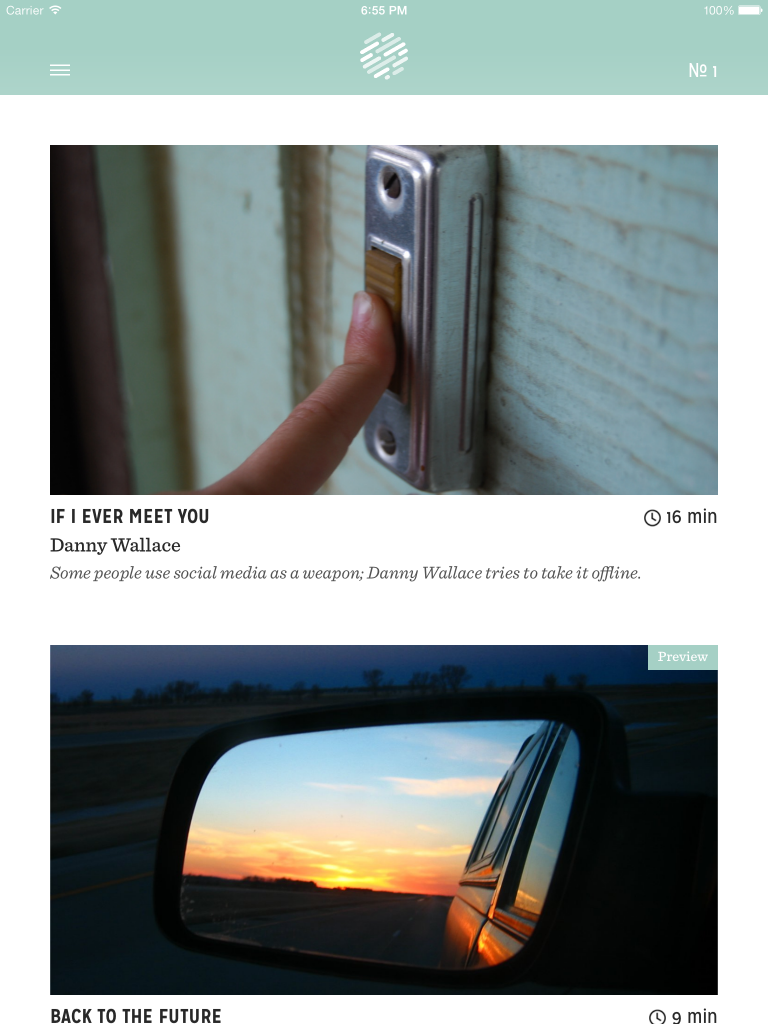After working at Apple’s Cupertino headquarters for three years, Tom Smith got the entrepreneurial itch. Armed with a strong team, the Toronto-native is looking to try and new model in journalism and publishing: one where each writer takes home 10 percent of the revenue from an issue of Offline Magazine.
Offline Magazine is a new digital magazine available only on iPhones and iPads, featuring five high-quality writers every issue who contribute TED talk-like feature content. Half of the total revenues from an issue is split among the five writers. An issue costs 99 cents.
“If you do the math in your head, even with a fairly small subscriber base, we’re going to be able to exceed two dollars per word for an article right off the bat,” said the cofounder Smith. “That’s the ultimate goal, and then we’ll try and do multiples of that.”
He explained that even for writers at the top of their game who are writing in the biggest publications, like the New Yorker, GQ, etc., they’re making between 50 cents and two dollars per word. That can often amount to $1000 per article, something Smith called kind of crazy. “What we really wanted to do was try and correct that imbalance and put money back in the hands of those who actually create the content and those who have the ideas.”
The clear challenge will be Offline Magazine’s ability to broadcast to the world that they exist, something every startup, as well as Smith, are aware of. Smith knows they need to get a large subscriber base and scale quickly in order to meet his dreams of paying a writer $5,000 per article (yes, he did say that writers). His solution? Along with finding high-quality writers, Offline Magazine is also targeting social media-savvy writers who possess a large social reach. The first issue is set to go on the Twitter feeds of 1.5 million people already, and more through the writers’ Facebooks and personal websites.
“So its about empowering writers to write what they want to write about, empowering writers to better compensation and a more fair model, and also, incentivizing them through revenue-sharing to help us promote, to scale, and to help us tap into the people on Twitter who have chosen to hear what these people want to say.”
The only thing I might say about that is, some of the best writers I know and have met in my life don’t even have a Facebook. That’s because they’re often zany, creative, or different then most of us. And along with that, they don’t care about validating themselves through artificial social communities. So should adherence to sites like Facebook or Twitter hinder Offline Magazine’s potential ability to pick the best writers? Perhaps, but once Offline Magazine starts earning enough money, it could rely less on the writers’ social reach and more on the strength of the brand.
Having downloaded the app already and skimmed through the stories, I already really like Offline Magazine. The user interface is really nice and clean, and the content already has me ready to read. “Wrestling George” is a piece by Josh Gondelman about how “George Castanza is Josh Gondelman’s inner voice and occasional tormentor,” while “The Limits of Empathy” is a piece by Jack Cheng about “How honest can we be when discussing life-changing decisions with our friends?”
The last gem that Offline Magazine throw at readers is the audio part: every article comes in audio, scripted by voice actors and packaged by professionals, and even word-mapped onto the app. That means if a reader has to get up and transfer to a different subway line, he or she can simply tap the word they stopped at and resume listening.
While the office is based out of San Francisco, where Smith spent time toiling away among engineers in the Siri and Maps departments of Apple, the team represents a Can/Am collaboration. While Smith is from Toronto, his lead engineer lives in Waterloo. One cofounder is from Detroit, while two designers live in Brooklyn. The team possesses experience at NYTimes, Audible and Instagram.
For Smith, he just wants the writers to earn some coin. “I work towards getting our writers paid.”




